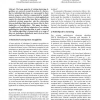Free Online Productivity Tools
i2Speak
i2Symbol
i2OCR
iTex2Img
iWeb2Print
iWeb2Shot
i2Type
iPdf2Split
iPdf2Merge
i2Bopomofo
i2Arabic
i2Style
i2Image
i2PDF
iLatex2Rtf
Sci2ools
CEC
2005
IEEE
2005
IEEE
Multiobjective clustering around medoids
Abstract- The large majority of existing clustering algorithms are centered around the notion of a feature, that is, individual data items are represented by their intrinsic properties, which are summarized by (usually numeric) feature vectors. However, certain applications require the clustering of data items that are defined by exclusively extrinsic properties: only the relationships between individual data items are known (that is, their similarities or dissimilarities). This paper develops a straightforward and efficient adaptation of our existing multiobjective clustering algorithm to such a scenario. The resulting algorithm is demonstrated on a range of data sets, including a dissimilarity matrix derived from real, non-feature-based data. 1 Similarity-based pattern recognition A large majority of techniques for pattern recognition are designed for the analysis of data that are described by means of numerical feature vectors. Well-known examples of such techniques are principal ...
| Added | 24 Jun 2010 |
| Updated | 24 Jun 2010 |
| Type | Conference |
| Year | 2005 |
| Where | CEC |
| Authors | Julia Handl, Joshua D. Knowles |
Comments (0)

